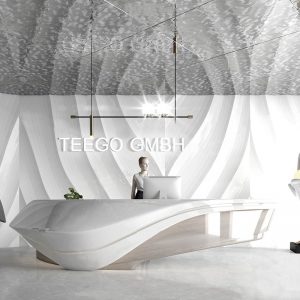The design of hospital furniture involves many parameters such as human body engineering, color aesthetics, material characteristics and functional requirements. Compared with civil furniture, it has higher requirements in safety, humanization, corrosion resistance, wear resistance and durability. Therefore, the personalized demand of medical furniture is becoming more and more prominent today, how to design medical furniture that meets the needs of the market? According to the development trend of medical furniture design at home and abroad, the following six design principles are summarized.
I. Principles of environmental protection.
Medical furniture is closely related to human health, and environmental protection is the first standard to measure the quality of medical furniture. Therefore, when choosing medical furniture, environmental protection should be considered first. From product design, material selection, manufacturing, transportation, installation, use and other aspects to consider the environmental protection of products.

Two, function principle.
Functional design of medical furniture includes two aspects: material function and spiritual function.
Functional design: design the product’s own functions, such as sitting, lying, leaning, storage, etc. In addition, it is necessary to consider processing technology design, industrial production and loading and unloading, stacking, folding, disassembly and so on. According to the use requirements of different departments, to meet the special function design. Such as barrier-free design, kneepad space, medical gas logistics pipeline layout, etc.
Functional design: it refers to satisfying people’s psychological needs and making them happy in use. For different areas, can be differentiated from color, material, modeling and other aspects of the design, so that patients from the psychological and spiritual relief.
Third, the principle of safety.
Most of the hospitalized patients were unhealthy. The selection of hospital furniture should pay more attention to structural stability, stability and absence of acute Angle risk factors than that of healthy people and other environments. In addition, in order to effectively prevent nosocomial infection, it is necessary to design furniture products that are easy to clean.
4. The principle of adaptation.
Adaptability refers to the design of hospital furniture to meet the needs of future hospital development from the perspective of meeting the needs of the whole life cycle of the hospital. To this end, the modular and standardized design of medical furniture can enhance the expansibility of products, flexibly realize the splicing of various shapes, improve production efficiency and quality, and save costs.
5. Spatial matching principle.
Medical space is composed of architectural space, medical furniture, medical facilities and other medical function space. The size of each space, lighting, temperature, ventilation, sound, type and position, color, material, etc. As one of the “leading roles” of the medical space, its design should be closely combined with the overall environmental design of the hospital to meet the needs of medical work to the greatest extent and establish a patient-centered, warm, comfortable and convenient diagnosis and treatment environment.
Six, the principle of humanization.
People-oriented design concept has become a design trend. Medical furniture is a tool that patients contact closely in diagnosis and treatment environment, and its humanized design is particularly important. The humanized design of medical furniture not only facilitates the use of doctors and patients, but also better improves the hospital’s treatment environment and diagnosis and treatment services.
